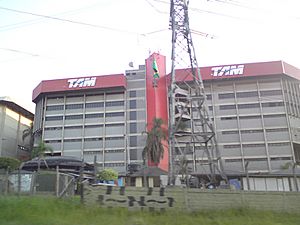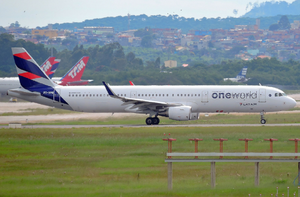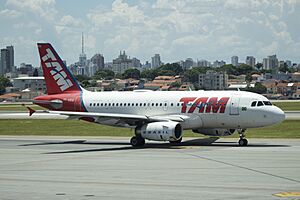LATAM Airlines Brasil facts for kids

A LATAM Airlines Brasil Boeing 787-9
|
|
| Founded |
|
|---|---|
| Commenced operations |
|
| AOC # | 13,221 (November 24, 2023) |
| Hubs |
|
| Focus cities |
|
| Frequent-flyer program | LATAM Pass |
| Fleet size | 157 |
| Destinations | 93 |
| Parent company | LATAM Airlines Group |
| Headquarters | São Paulo, Brazil |
| Key people | Jerome Cadier (CEO) |
| Revenue | |
| Net income | |
LATAM Airlines Brasil is a major airline in Brazil. It used to be called TAM Linhas Aéreas. It's part of the LATAM Airlines Group, which is a big airline company in Latin America. LATAM Airlines Brasil flies to many places both inside Brazil and around the world. Its main bases are in Brasília, Fortaleza, and São Paulo.
This airline is the largest in Brazil for both domestic (inside Brazil) and international flights. It carries a lot of passengers every year. Before it joined with the Chilean airline LAN Airlines, TAM Linhas Aéreas was the biggest airline in Brazil and Latin America. Its main office was in São Paulo. The name "TAM" comes from "Transportes Aéreos Marília," which was the original name of the company when it started in Marília, a city in the state of São Paulo.
Contents
History
How the Airline Started
The airline started on February 21, 1961, as a small air taxi company called TAM – Táxi Aéreo Marília. This company helped set up the bigger regional airline later on.
On November 11, 1975, the Brazilian government created a system for regional air travel. TAM – Transportes Aéreos Regionais S/A was one of the new airlines formed. It began flying on July 12, 1976. The airline was founded by Rolim Amaro. It first used small planes called Embraer EMB 110 Bandeirantes. These planes were too small, so TAM bought bigger Fokker F27 planes from the Netherlands. By 1983, TAM had 10 Fokker F27s. By 1984, the airline had flown 2 million passengers!
Growing and Joining Forces
In 1986, TAM – Transportes Aéreos Regionais (which had the flight code KK) bought another regional airline called VOTEC. VOTEC was renamed Brasil Central Linhas Aéreas. TAM and Brasil Central worked together, sharing their routes and planes, even though they had different flight codes (KK for TAM and JJ for Brasil Central).
In 1990, the government allowed regional airlines to fly anywhere in Brazil. Brasil Central then changed its name to TAM - Transportes Aéreos Meridionais and started using the same colors as TAM (KK), but kept its JJ flight code. In 2000, the two TAM companies officially merged, and the airline became known as TAM Transportes Aéreos, keeping the JJ code.
Adding New Planes and International Flights
In 1989, TAM started using Fokker 100 jet planes. By 1993, TAM had 14 Fokker 100s and flew to 56 cities in Brazil.
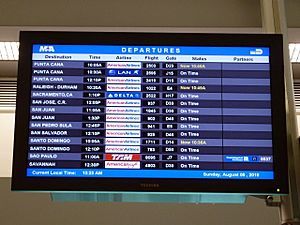
In 1997, TAM ordered its first large jets from Airbus, including A330s, A319s, and A320s. That same year, TAM started its first international flight from São Paulo to Miami International Airport. In 1999, it began flights to Europe (Paris) by working with Air France. In 2000, the airline was officially renamed TAM Linhas Aéreas.
TAM also bought other smaller airlines over the years, like Helisul Linhas Aéreas in 1996 and Pantanal Linhas Aéreas in 2009. Pantanal later fully joined TAM in 2013.
Becoming LATAM Airlines Group
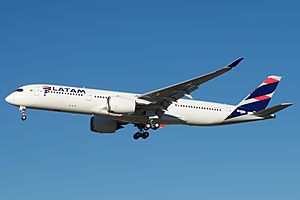

On August 13, 2010, TAM agreed to merge with LAN Airlines, a Chilean airline. This created a huge new airline group called LATAM Airlines Group. The merger was completed on June 22, 2012. As of May 5, 2016, TAM officially changed its name to LATAM. Even though the name changed, the flights operated by the Brazilian part of the company still use "TAM" as their call sign.
In July 2020, LATAM Brasil faced financial challenges due to the global COVID-19 pandemic. The company started a process to reorganize its business to help it recover. Despite this, the airline continued to fly normally.
LATAM Paraguay
In 1994, TAM Linhas Aéreas started a small airline in Paraguay called Aerolíneas Paraguayas. Later, in 1996, TAM bought most of the shares of the state-owned airline Líneas Aéreas Paraguayas and merged it with ARPA. The new airline was called TAM – Transportes Aéreos del Mercosur. In 2008, it changed its name to match TAM Airlines, and was often called TAM Paraguay. In 2016, it was rebranded to LATAM Paraguay, just like the other airlines in the LATAM group.
Where LATAM Brasil Flies
LATAM Brasil and LATAM Paraguay fly to many places in Brazil, Paraguay, Africa, Europe, North America, and South America.
As of January 2024, LATAM Brasil (which used to be TAM Linhas Aéreas) flies to the places listed below. This list also includes places that its former smaller airlines, Pantanal Linhas Aéreas and TAM Paraguay, used to fly to.
| Country | City | Airport | Notes | Refs |
|---|---|---|---|---|
| Argentina | Bariloche | Teniente Luis Candelaria International Airport | Seasonal | |
| Buenos Aires | Aeroparque Jorge Newbery | |||
| Ministro Pistarini International Airport | ||||
| Córdoba | Ingeniero Aeronáutico Ambrosio L.V. Taravella International Airport | Terminated | ||
| Mendoza | Governor Francisco Gabrielli International Airport | |||
| Rosario | Islas Malvinas International Airport | Terminated | ||
| San Miguel de Tucumán | Teniente General Benjamín Matienzo International Airport | Terminated | ||
| Bolivia | Cochabamba | Jorge Wilstermann International Airport | Terminated | |
| La Paz | El Alto International Airport | Terminated | ||
| Santa Cruz de la Sierra | Viru Viru International Airport | Suspended | ||
| Brazil | Aracaju | Santa Maria Airport | ||
| Aracati | Dragão do Mar Regional Airport | operated by Voepass | ||
| Araçatuba | Dario Guarita State Airport | Terminated | ||
| Araraquara | Bartolomeu de Gusmão State Airport | Terminated | ||
| Barreiras | Barreiras Airport | operated by Voepass | ||
| Bauru | Comte. João Ribeiro de Barros Airport | Terminated | ||
| Bauru/Arealva | Noussa Nakhal Tobias State Airport | Terminated | ||
| Belém | Val-de-Cans International Airport | |||
| Belo Horizonte | Confins–Tancredo Neves International Airport | Focus city | ||
| Boa Vista | Atlas Brasil Cantanhede International Airport | |||
| Brasília | Pres. Juscelino Kubitschek International Airport | Hub | ||
| Cabo Frio | Cabo Frio International Airport | Terminated | ||
| Caldas Novas | Nelson Ribeiro Guimarães Airport | Seasonal | ||
| Campinas | Viracopos International Airport | Resumes 1 August 2025 | ||
| Campo Grande | Campo Grande International Airport | |||
| Cascavel | Regional West Airport | |||
| Caxias do Sul | Hugo Cantergiani Regional Airport | |||
| Chapecó | Serafin Enoss Bertaso Airport | |||
| Corumbá | Corumbá International Airport | Terminated | ||
| Criciúma/Forquilhinha | Diomício Freitas Airport | Terminated | ||
| Cuiabá/Várzea Grande | Mal. Rondon International Airport | |||
| Curitiba | Afonso Pena International Airport | |||
| Fernando de Noronha | Gov. Carlos Wilson Airport | operated by Voepass | ||
| Florianópolis | Hercílio Luz International Airport | Focus city | ||
| Fortaleza | Pinto Martins International Airport | Hub | ||
| Foz do Iguaçu | Cataratas International Airport | |||
| Franca | Ten. Lund Presotto State Airport | Terminated | ||
| Goiânia | Santa Genoveva International Airport | |||
| Ilhéus | Jorge Amado Airport | |||
| Imperatriz | Pref. Renato Moreira Airport | |||
| Ipatinga | Vale do Aço Regional Airport | operated by Voepass | ||
| Jaguaruna/Criciúma | Humberto Ghizzo Bortoluzzi Airport | |||
| Jericoacoara | Comte. Ariston Pessoa Regional Airport | |||
| Ji-Paraná | José Coleto Airport | Terminated | ||
| João Pessoa | Pres. Castro Pinto International Airport | |||
| Joinville | Lauro Carneiro de Loyola Airport | |||
| Juazeiro do Norte | Orlando Bezerra de Menezes Airport | |||
| Juiz de Fora | Francisco Álvares de Assis Airport | Terminated | ||
| Goianá–Pres. Itamar Franco Regional Airport | ||||
| Lençóis | Cel. Horácio de Mattos Airport | operated by Voepass | ||
| Londrina | Gov. José Richa Airport | |||
| Macapá | Alberto Alcolumbre International Airport | |||
| Maceió | Zumbi dos Palmares International Airport | |||
| Manaus | Eduardo Gomes International Airport | |||
| Marabá | João Correa da Rocha Airport | |||
| Marília | Frank Milenkovich Airport | Terminated | ||
| Maringá | Sílvio Name Júnior Regional Airport | |||
| Montes Claros | Mário Ribeiro Airport | |||
| Natal | Parnamirim–Augusto Severo International Airport | Airport closed | ||
| São Gonçalo do Amarante–Gov. Aluízio Alves International Airport | ||||
| Navegantes | Min. Victor Konder International Airport | |||
| Ourinhos | Jornalista Benedito Pimentel Airport | Terminated | ||
| Palmas | Brig. Lysias Rodrigues Airport | |||
| Passo Fundo | Lauro Kurtz Airport | |||
| Paulo Afonso | Paulo Afonso Airport | operated by Voepass | ||
| Pelotas | João Simões Lopes Neto International Airport | operated by Voepass | ||
| Petrolina | Sen. Nilo Coelho Airport | |||
| Porto Alegre | Salgado Filho International Airport | Focus city | ||
| Porto Seguro | Porto Seguro Airport | |||
| Porto Velho | Gov. Jorge Teixeira de Oliveira International Airport | |||
| Presidente Prudente | Presidente Prudente State Airport | operated by Voepass | ||
| Recife | Guararapes–Gilberto Freyre International Airport | Focus city | ||
| Ribeirão Preto | Leite Lopes Airport | |||
| Rio Branco | Plácido de Castro International Airport | |||
| Rio de Janeiro | Galeão–Antonio Carlos Jobim International Airport | Focus city | ||
| Santos Dumont Airport | ||||
| Salvador | Dep. Luís Eduardo Magalhães International Airport | |||
| Santa Maria | Santa Maria Airport | operated by Voepass | ||
| Santarém | Maestro Wilson Fonseca Airport | |||
| Santo Ângelo | Sepé Tiaraju Airport | operated by Voepass | ||
| São José do Rio Preto | Prof. Eribelto Manoel Reino State Airport | |||
| São José dos Campos | Prof. Urbano Ernesto Stumpf International Airport | Terminated | ||
| São Luís | Mal. Cunha Machado International Airport | |||
| São Paulo | Congonhas–Dep. Freitas Nobre Airport | Hub | ||
| Guarulhos–Gov. André Franco Montoro International Airport | Hub | |||
| Sinop | Pres. João Figueiredo Airport | |||
| Teixeira de Freitas | 9 de maio Airport | operated by Voepass | ||
| Teresina | Sen. Petrônio Portella Airport | |||
| Uberaba | Mário de Almeida Franco Airport | Terminated | ||
| Uberlândia | Ten. Cel. Av. César Bombonato Airport | |||
| Una | Una-Comandatuba Airport | |||
| Uruguaiana | Ruben Berta International Airport | operated by Voepass | ||
| Valença | Valença Airport | operated by Voepass | ||
| Vilhena | Brig. Camarão Airport | Terminated | ||
| Vitória | Eurico de Aguiar Salles Airport | |||
| Vitória da Conquista | Glauber Rocha Airport | |||
| Canada | Toronto | Toronto Pearson International Airport | Terminated | |
| Chile | Santiago | Arturo Merino Benítez International Airport | ||
| Colombia | Bogotá | El Dorado International Airport | ||
| Dominican Republic | Punta Cana | Punta Cana International Airport | Terminated | |
| France | Paris | Charles de Gaulle Airport | ||
| Germany | Frankfurt | Frankfurt Airport | ||
| Italy | Milan | Milan Malpensa Airport | ||
| Rome | Leonardo da Vinci–Fiumicino Airport | |||
| Mexico | Cancún | Cancún International Airport | Terminated | |
| Mexico City | Benito Juárez International Airport | |||
| Paraguay | Asunción | Silvio Pettirossi International Airport | ||
| Ciudad del Este | Guaraní International Airport | Terminated | ||
| Peru | Lima | Jorge Chávez International Airport | ||
| Portugal | Lisbon | Humberto Delgado Airport | ||
| South Africa | Johannesburg | O. R. Tambo International Airport | ||
| Spain | Barcelona | Josep Tarradellas Barcelona–El Prat Airport | ||
| Madrid | Adolfo Suárez Madrid–Barajas Airport | |||
| Switzerland | Zürich | Zürich Airport | Terminated | |
| United Kingdom | London | Heathrow Airport | ||
| Stanley | RAF Mount Pleasant | Terminated | ||
| United States | Boston | Logan International Airport | ||
| Las Vegas | Harry Reid International Airport | Terminated | ||
| Los Angeles | Los Angeles International Airport | |||
| Miami | Miami International Airport | |||
| New York City | John F. Kennedy International Airport | |||
| Orlando | Orlando International Airport | |||
| Uruguay | Montevideo | Carrasco/General Cesáreo L. Berisso International Airport | ||
| Punta del Este | Capitán de Corbeta Carlos A. Curbelo International Airport | Terminated | ||
| Venezuela | Caracas | Simón Bolívar International Airport | Terminated |
Working with Other Airlines
LATAM Brasil works with other airlines through "codeshare agreements." This means they sell tickets for flights operated by other airlines, and vice versa. It helps passengers have more choices for their travel.
- Aeroméxico
- Air China
- Austrian Airlines
- British Airways
- Cathay Pacific
- Delta Air Lines
- Finnair
- Iberia
- Japan Airlines
- Korean Air
- LATAM Chile
- LATAM Paraguay
- LATAM Perú
- Lufthansa
- Qantas
- Qatar Airways
- South African Airways
- Swiss International Air Lines
- TAP Air Portugal
- Turkish Airlines
- Virgin Atlantic
- Voepass
- Vueling
- WestJet
LATAM Brasil's Airplanes
LATAM Brasil uses many different types of airplanes to fly its passengers.
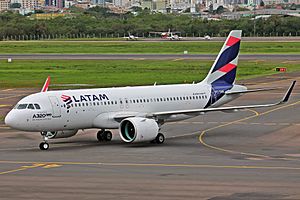
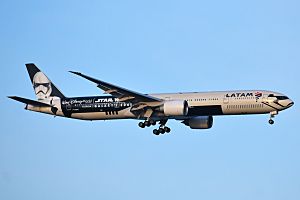
Planes They Use Now
As of January 2025, LATAM Brasil flies these aircraft:
| Aircraft | In service |
Orders | Passengers | Notes | |||
|---|---|---|---|---|---|---|---|
| J | W | Y | Total | ||||
| Airbus A319-100 | 19 | — | – | – | 144 | 144 | |
| Airbus A320-200 | 57 | — | – | – | 162 | 162 | 5 operating for LATAM Paraguay. |
| 174 | 174 | ||||||
| 180 | 180 | ||||||
| Airbus A320neo | 21 | — | – | – | 174 | 174 | |
| 180 | 180 | ||||||
| Airbus A321-200 | 31 | — | – | – | 224 | 224 | Older aircraft to be replaced by Airbus A321neo. |
| Airbus A321neo | 14 | 9 | – | – | 224 | 224 | To replace older Airbus A321-200. |
| Boeing 777-300ER | 10 | — | 38 | 50 | 322 | 410 | |
| Boeing 787-9 | 1 | — | 30 | 57 | 216 | 303 | Taken over from LATAM Chile. |
| Total | 153 | 9 | |||||
Planes They Used Before
LATAM Brasil has used these aircraft in the past:
| Aircraft | Total | Introduced | Retired | Notes |
|---|---|---|---|---|
| Airbus A330-200 | 22 | 1998 | 2016 | |
| Airbus A340-500 | 2 | 2007 | 2011 | Leased from Air Canada. |
| Airbus A350-900 | 13 | 2016 | 2021 | Subleased to other airlines. Replaced by Boeing 787. |
| Boeing 767-300ER | 19 | 2008 | 2023 | |
| Cessna 170A | 1 | 1961 | Unknown | |
| Cessna 180 | 4 | 1961 | Unknown | |
| Cessna 206 Stationair | 1 | 1961 | Unknown | |
| Cessna 208B Grand Caravan | 39 | 1996 | 2012 | |
| Cessna 402B | 4 | 1972 | 1979 | |
| Embraer EMB 110 Bandeirante | 15 | 1976 | 1996 | |
| Fokker F27 | 10 | 1980 | 2000 | |
| Fokker 50 | 9 | 1995 | 2001 | |
| Fokker 100 | 51 | 1990 | 2008 | Most were taken from orders of Sempati Air and Pan Am. |
| Learjet 24 | 1 | 1984 | Unknown | |
| Learjet 25 | 6 | 1974 | Unknown | |
| Learjet 35 | 1 | 2007 | Unknown | |
| McDonnell Douglas MD-11 | 1 | 2007 | 2008 | Leased from Boeing Capital. |
| McDonnell Douglas MD-11ER | 2 | |||
| Mitsubishi MU-2 | 1 | 1994 | 1999 | |
| Piper PA-31-350 Navajo | 1 | 1976 | 1984 |
New Plane Orders
LATAM Airlines Brasil often orders new planes to update its fleet. For example, in 2005, TAM ordered 20 new Airbus A320 family aircraft. They also planned to buy 10 new Airbus A350-900 planes. The first A350 arrived in early 2016.
The airline also signed a deal for 37 more aircraft from Airbus, including A319s, A320s, A321s, and A330s. This brought the total number of planes bought directly from Airbus to 115. The airline also received its first A320 family aircraft with special wingtips called "Sharklets" in April 2013.
LATAM Airlines Brasil takes care of its planes at a special technology center located at São Carlos Airport.
Other Parts of the Company
LATAM Airlines Group has several other businesses:
- LATAM Cargo Brasil handles cargo and freight services.
- Multiplus Fidelidade is a loyalty program where customers can earn points for flights and other purchases.
- TAM Aviação Executiva offers air services for business travelers.
- TAM Viagens helps Brazilians plan their vacations, and TAM Vacations does the same for Americans.
- TAM Museum was a museum in São Carlos that showed old airplanes.
See also
 In Spanish: LATAM (Brasil) para niños
In Spanish: LATAM (Brasil) para niños
- Brasil Central Linhas Aéreas
- Helisul Linhas Aéreas
- List of airlines of Brazil


